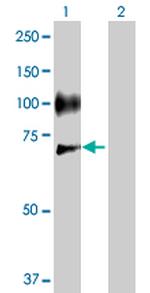Search Thermo Fisher Scientific
图: 1 / 1
SELE Antibody (H00006401-D01P) in WB
Lane 1: SELE transfected lysate(66.70 KDa).
Lane 2: Non-transfected lysate.

产品信息
H00006401-D01P
种属反应
宿主/亚型
分类
类型
抗原
偶联物
形式
浓度
纯化类型
保存液
内含物
保存条件
运输条件
产品详细信息
Sequence of this protein is as follows: MIASQFLSAL TLVLLIKESG AWSYNTSTEA MTYDEASAYC QQRYTHLVAI QNKEEIEYLN SILSYSPSYY WIGIRKVNNV WVWVGTQKPL TEEAKNWAPG EPNNRQKDED CVEIYIKREK DVGMWNDERC SKKKLALCYT AACTNTSCSG HGECVETINN YTCKCDPGFS GLKCEQIVNC TALESPEHGS LVCSHPLGNF SYNSSCSISC DRGYLPSSME TMQCMSSGEW SAPIPACNVV ECDAVTNPAN GFVECFQNPG SFPWNTTCTF DCEEGFELMG AQSLQCTSSG NWDNEKPTCK AVTCRAVRQP QNGSVRCSHS PAGEFTFKSS CNFTCEEGFM LQGPAQVECT TQGQWTQQIP VCEAFQCTAL SNPERGYMNC LPSASGSFRY GSSCEFSCEQ GFVLKGSKRL QCGPTGEWDN EKPTCEAVRC DAVHQPPKGL VRCAHSPIGE FTYKSSCAFS CEEGFELYGS TQLECTSQGQ WTEEVPSCQV VKCSSLAVPG KINMSCSGEP VFGTVCKFAC PEGWTLNGSA ARTCGATGHW SGLLPTCEAP TESNIPLVAG LSAAGLSLLT LAPFLLWLRK CLRKAKKFVP ASSCQSLESD GSYQKPSYIL
靶标信息
Leukocytes adhere to the blood vessel endothelium during extravasation in postcapillary venules of lymph nodes. In addition, leukocyte adhesion occurs in the capillaries and small venules at any site in the body after onset of inflammation. This response is immediate and involves a cascade of adhesion receptors. At the endothelial surface members of the selectin and immunoglobulin superfamilies participate in this cascade. Selectins are C-type cell surface lectins that play a role in leukocyte adhesion to the blood vessel wall endothelium. E-selectin (CD62E) is an endothelial cell specific selectin that is expressed only after activation with proinflammatory cytokines. In vitro experiments have shown that IL-1, TNFalpha and bacterial wall components like lipopolysaccharides induce the transcription of E-selectin in a NFkB dependent signaling cascade. E-selectin has been associated with blood vessel endothelium in diverse inflammatory situations.
仅用于科研。不用于诊断过程。未经明确授权不得转售。
篇参考文献 (0)
生物信息学
蛋白别名: CD62 antigen-like family member E; CD62E; e selectin; E-selectin; ELAM-1; endothelial adhesion molecule 1; Endothelial leukocyte adhesion molecule 1; LECAM2; leukocyte endothelial cell adhesion molecule 2; Leukocyte-endothelial cell adhesion molecule 2; RP1-117P20.2
基因别名: CD62E; ELAM; ELAM1; ESEL; LECAM2; SELE
UniProt ID: (Human) P16581
Entrez Gene ID: (Human) 6401



